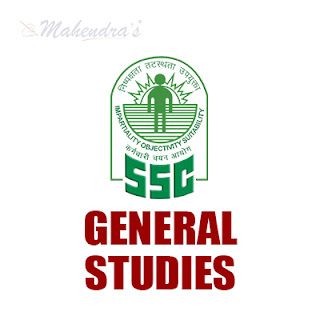General Studies can be one of most scoring and marks gaining section in the SSC exam. This section doesn’t require any calculations and is thus the least time-consuming section, unlike other section. You can attempt this section very quickly and accurately. General Studies basically judge your basic general knowledge and how you are getting yourself updated time to time. It plays a vital role and benefits you to achieving the score required to cross the total cut off marks. Mahendra Guru providing you with an important General Studies quiz for SSC exam, it will help you to score if you regularly follow the contents of our website. We also provide you General Studies Quiz for SSC examination based on the latest pattern.So, that you can practice on regular basis. It will definitely help you to score good marks in the exam. It is the most important section for all the govt exam Insurance, SSC-MTS, CGL, CHSL, State Level and other Competitive exams.
You can clear your doubts before an exam. Mahendra Guru also provides you with an important note and study material for all subject and test through its website, Mahendra Guru App and YouTube channel apart from it Speed Test Portal. Most of these preparation products are also available for purchase at my shop. You can also visit Mahendras.org to get more information about our endeavour for your success. You can also study in details through our E-Mahendras Facebook and Mahendra Guru YouTube channel of General Studies.
Q.1. When a light wave is reflected from a mirror, there is a change in its
A. Frequency
A. Frequency
B. Amplitude
C. Wavelength
D. Velocity
Q.1. जब एक लाइट लहर एक दर्पण से परिलक्षित होती है, तो इसके में एक बदलाव होता है
A. आवृत्ति
B. आयाम
C. तरंग दैर्ध्य
D. वेग
Q.2. Solar energy is due to
A. Fusion reactions
B. Fission reactions
C. Combustion reactions
D. Chemical reactions
Q.2. सौर ऊर्जा किस वजह से है
A. संलयन प्रतिक्रियाएं
B. विखंडन प्रतिक्रियाएं
C. दहन प्रतिक्रियाएं
D. रासायनिक प्रतिक्रियाओं
Q.3. The degree of monopoly power is to be measured in terms of the firm’s
A. Normal profit
B. Supernormal profit
C. Both normal and supernormal profit
D. Selling price
Q.3. फर्म की दृष्टि से एकाधिकार शक्ति की डिग्री को मापा जाना चाहिए
A. सामान्य लाभ
B. सुपरमानात्मक लाभ
C. दोनों सामान्य और असाधारण लाभ
D. बिक्री मूल्य
Q.4. Huge deposits of uranium were recently found in
A. Andhra Pradesh
B. Karnataka
C. Kerala
D. Tamil Nadu
Q.4. हाल ही में यूरेनियम की भारी जमाराशि पाया गया
A. आंध्र प्रदेश
B. कर्नाटक
C. केरल
D. तमिलनाडु
Q.5. When water itself combines chemically with some element or mineral it is called
A. Carbonation
B. Desalination
C. Hydration
D. Oxidation
Q.5. जब पानी ही रासायनिक रूप से कुछ तत्व या खनिज के साथ जोड़ता है इसे कहा जाता है
A. कार्बोनेशन
B. डिसेलिनेशन
C. हाइड्रेशन
D. ऑक्सीकरण
Q.6. From the bark of which plant is quinine extracted?
A. Eucalyptus
B. Cinchona
C. Neem
D. Cedar
Q.6. किस पौधे की छाल से क्विनिन निकाला जाता है?
A. नीलगिरी
B. सिंचोना
C. नीम
D. देवदार
Q.7. Hypertension is the term used for
A. Increase in heart rate
B. Decrease in heart rate
C. Decrease in blood pressure
D. Increase in blood pressure
Q.7. उच्च रक्तचाप के लिए इस्तेमाल होने वाले शब्द है
A. हृदय गति में वृद्धि
B. हृदय गति में कमी
C. रक्तचाप में कमी
D. रक्तचाप में वृद्धि
Q.8. The contractile proteins in a muscle are
A. Actin and Myosin
B. Actin and Tropomyosin
C. Myosin and Troponin
D. Troponin and Tropomyosin
Q.8. मांसपेशी में सिकुड़ा हुआ प्रोटीन हैं
A. एक्टिन और मायोसिन
B. एक्टिन और ट्रोपोमायसिन
C. मायोसिन और ट्रोपोनिन
D. ट्रोपोनिन और ट्रोपोमायसिन
Q.9. Coins made of metal first appeared in
A. Harappan Civilization
B. Later Vedic Age
C. Age of the Buddha
D. Age of the Mauryas
Q.9. धातु के बने सिक्के पहले छपे
A. हड़प्पा सभ्यता
B. उत्तर-काल का वैदिक एज
C. बुद्ध की आयु
D. मौर्य के आयु
Q.10. A natural region has the similarity of
A. Climate and natural vegetation
B. Climate and occupation
C. Soil and drainage
D. Economic base
Q.10. एक प्राकृतिक क्षेत्र की समानता है
A. जलवायु और प्राकृतिक वनस्पति
B. जलवायु और व्यवसाय
C. मिट्टी और जल निकासी
D. आर्थिक आधार
Answers :
Q.1 (b) Q.2 (a) Q.3 (b) Q.4 (a) Q.5 (c) Q.6 (b) Q.7 (d) Q.8 (a) Q.9 (b) 180 (a)





